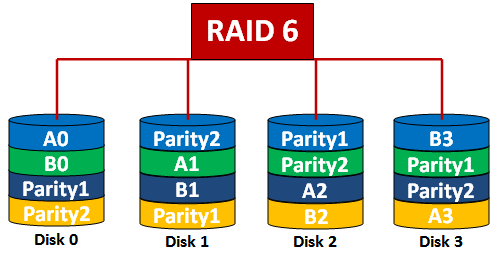RAID 6 - Striping with Double Parity

RAID 6 is not commonly used. It requires at least 4 drives. Data blocks are striped across the drives and portion of each drive has parity algorithms of the other drives. Unlike a RAID 5, each version of parity is saved to TWO separate drives. Using the parity data, the computer can recalculate the data blocks, should they no longer be available. That means a RAID 6 array can withstand a double drive failure without losing data or access to data. A RAID 6 can be achieved via software or a hardware controller. RAID 6 has some very important advantages. Access to data is very fast and if a drive, or even two, fails, there is still access to data, even while the failed drives are being replaced and the data is being rebuilt on the new drives. There are some disadvantages. Write time is a bit slower due to the need to write parity. RAID 6 systems can also add to a false sense of security. RAID 6 is ideal for critical data that has to be read at a high speed due to the number of users accessing the data source at the same time. If the RAID 6 is diligently maintained, it is awesome for data that absolutely must be available at all times.
Data Recovery from a Failed RAID 6
The first thing we do is assess each individual drive. Once the initial problem for each drive has been bypassed, we make a sector by sector clone of each drive using a tool specifically designed for this process. We then take these clones and rebuild the RAID in a virtual environment. This process takes a highly skilled engineer and more specifically designed equipment and software to accomplish. The trick to this is that we often run into situations where a drive or two have failed and gone unnoticed for hours, days, or even years. The data on those drives is stale and makes the data come up as corrupt. We have to find that drive and eliminate it from the mix. We then have access to data that can be tested for integrity and functionality.




